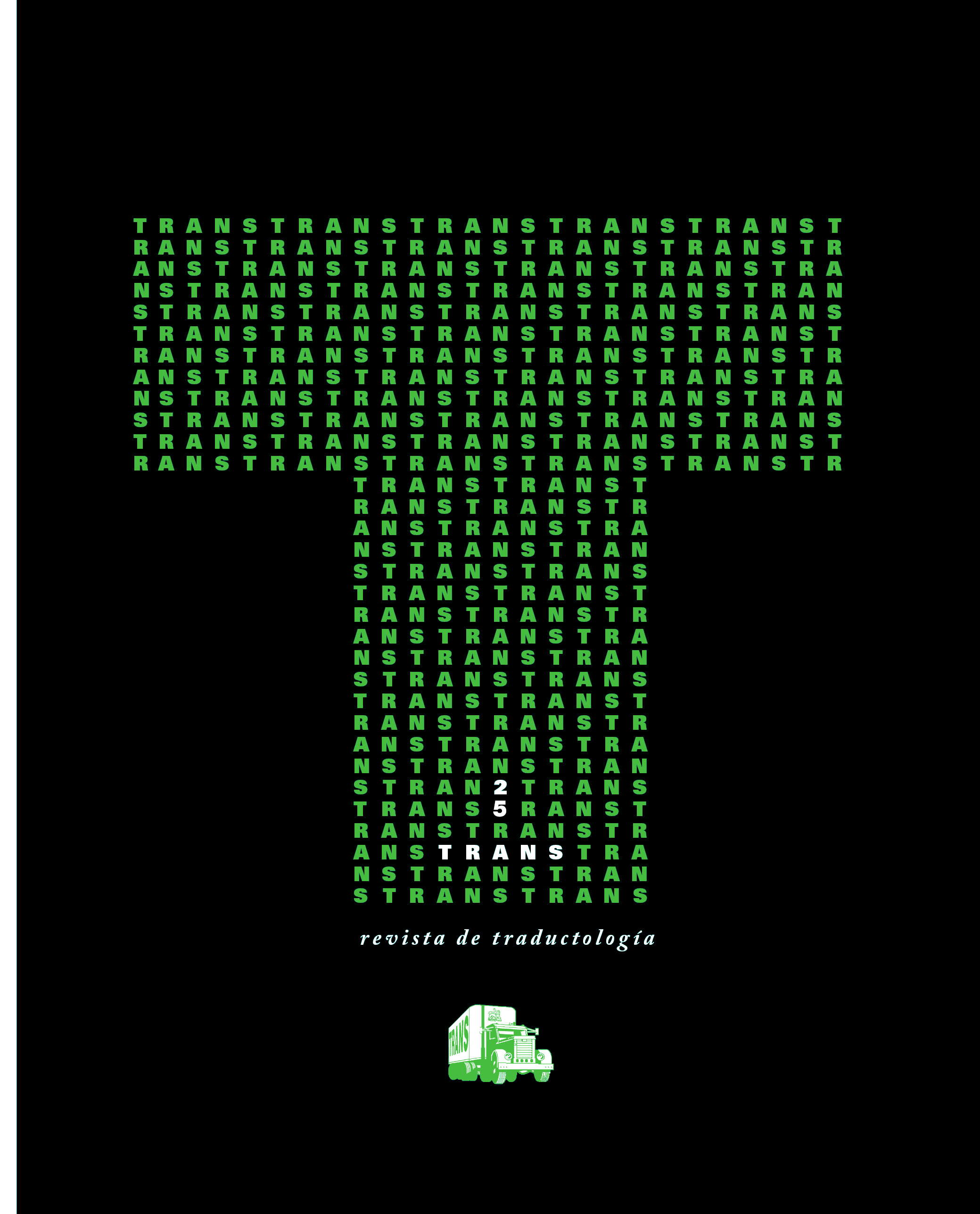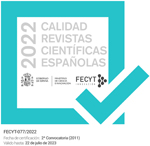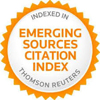«As if her eyes were suns»: the marking of metaphor in audio description of art for blind and partially sighted people
DOI:
https://doi.org/10.24310/TRANS.2021.v1i25.12380Keywords:
audio description, accessible museology, contemporary art, deliberate metaphor, metaphorical markersAbstract
More and more museums are using audio description to facilitate access for blind and partially sighted visitors. There are several tools to rephrase the images depicted in art and translate them into speech. This article focuses on deliberate metaphor, a tool the audio describer consciously uses by comparing the unfamiliar visual element with the familiar experience, usually with a «marker» that catches the attention of the receiver, such as like or similar to. It helps to create a mental image through their knowledge of the world.
Downloads
Metrics
Publication Facts
Reviewer profiles N/A
Author statements
Indexed in
-
—
- Academic society
- N/A
- Publisher
- Universidad de Málaga
References
Cameron, Lynne (2003): Metaphor in educational discourse, Londres y Nueva York: Continuum.
Cameron, Lynne & Alice Deignan (1998): «Metaphor signalling devices in talk: Tuning intersubjectivity», Actas del BAAL, septiembre de 1998, Mánchester: Universidad de Mánchester, 10-12.
Cameron, Lynne & Alice Deignan (2003): «Combining Large and Small Corpora to Investigate Tuning Devices Around Metaphor in Spoken Discourse», Metaphor and Symbol, 18/3, 149-160.
Charteris-Black, Jonathan (2012): «Forensic deliberations on purposeful metaphor», Metaphor and the Social World, 2/1, 1-12.
Charteris-Black, Jonathan & Andreas Musolff (2003) «‘Battered hero’ or ‘innocent victim’? A comparative study of metaphors for euro trading in British and German financial reporting», English for Specific Purpose, 22, 153-176.
Deignan, Alice (2011): «Deliberateness is not unique to metaphor. A response to Gibbs», Metaphor and the Social World, 1/1, 57-60.
Edo, Miquel (2018): «Hermenéutica de la audiodescripción museística ante las vanguardias históricas: reticencias hacia el antifigurativismo y potenciación de la polisemia», Arte, Individuo y Sociedad, 30/2, 415-430.
Gibbs, Raymond W. (2008): «Mind & Language», en Raymond W. Gibbs (ed.), The Cambridge Handbook of Metaphor and Thought, Nueva York: Cambridge University Press, 434-458.
Gibbs, Raymond W. (2011): «Are deliberate metaphors really deliberate? A question of human consciousness and action», Metaphor and the Social World, 1/1, 26-52.
Gibbs, Raymond W. (2015): «Do pragmatic signals affect conventional metaphor understanding? A failed test of deliberate metaphor theory», Journal of Pragmatics, 90, 77-87.
Goatly, Andrew (1997): The language of metaphors, Londres y Nueva York: Routledge, 66-77.
Goddard, Cliff (2004): «The ethnopragmatics and semantics of ‘active metaphors’», Journal of Pragmatics, 36, 1211-1230.
Jakobson, Roman (1959): «On linguistic aspects of translation”, en R. A. Brower, (ed.), On Translation, Harvard: Harvard University Press.
Luque Colmenero, María Olalla (2012): «De la metáfora visual a la metáfora lingüística en la audiodescripción», en Eduardo Salas (ed.), Arte y Significación, hacia una semiótica de la interpretación artística, Granada: Zumaya, 346-357.
Luque Colmenero, María Olalla y Silvia Soler (2020): «Metaphor as Creativity in Audio Descriptive Tours for Art Museums: From Description to Practice», Journal of Audiovisual Translation, 3/1, 64–78.
Miller, Anne (1993): «Images and models, similes and metaphors”, en Anthony Ortony (ed.), Metaphor and thought, Cambridge: Cambridge University Press, 357-400.
Miller, Steven y Marcel Fredericks (1990): «Perceptions of the crisis in American public education: the relationship of metaphors to ideology», Metaphor and Symbolic Activity, 5/2, 67-81.
Müller, Cornelia (2016): «Why mixed metaphors make sense”, en Raymond W. Gibbs (ed.), Mixing metaphor, Ámsterdam: John Benjamins, 31-56.
Ortony, Anthony (1993): Metaphor and Thought, Cambridge: Cambridge University Press.
Reijnierse, Gudrun (2017): The value of deliberate metaphor, Amsterdam Center for Language and Communication (ACLC), tesis doctoral inédita.
Reijnierse, Gudrun, Christian Burgers, Tina Krennmayr, y Gerard Steen (2018): «Metaphor in communication: The distribution of potentially deliberate metaphor across register and word class», Corpora, 14:3.
Reviers, Nina (2016): «Audio description services in Europe: An update», The Journal of Specialised Translation, 26, 232-247.
RNIB y Vocal Eyes (2003): The Talking Images Guide. Museumss, galleries and heritage site: improving access for blind and partially sighted people, Londres: RNIB.
Roncero, Carlos, Roberto de Almeida, Deborah Martin y Marco de Caro (2016): «Aptness predicts metaphor preference in the lab and on the internet», Metaphor and Symbol, 31/1, 31-46.
Salzhauer Axel, Elizabeth y Nina Sobol (2003): «AEB’s Guidelines for Verbal Description», en Salzhauer Axel, Elizabeth y Sobol, Nina (eds.), Art Beyond Sight: A resource guide to art, creativity, and visual impairment, Nueva York: AFB Press, 229-237.
Semino, Elena (2002): «A cognitive stylistic approach to mind style in narrative fiction», en Elena Semino y Jonathan Culpeper (eds.), Cognitive stylistics: Language and cognition in text analysis. Ámsterdam y Filadelfia: John Benjamins, 95-122.
Semino, Elena (2008): Metaphor in Discourse, Cambridge: Cambridge University Press.
Semino, Elena (2017): «Corpus Linguistics and Metaphor», en Dancygier, Barbara (ed.), The Cambridge Handbook of Cognitive Linguistics, Cambridge: Cambridge University Press, 463-476.
Snyder, Joel (2010): Guidelines for Audio Description Standards. American Council of the Blind. Versión electrónica: <http://www.acb.org/adp/about.html>.
Soler, Silvia (2013): La traducción accesible en el espacio multimodal museográfico, Córdoba: Universidad de Córdoba, tesis doctoral inedita.
Soler, Silvia y María Olalla Luque Colmenero (2018): «Paintings to my Ears: A Cognitive Corpus-based Approach to the Study of Audio Description in Art Museums», Linguistica Antverpiensia New Series – Themes in Translation Studies, 17, 140-156.
Spinzi, Cinzia G. (2020): «A cross-cultural study of figurative language in museum audio descriptions. Implications for translation», Lingue e Linguaggi, 33, 303-316.
Steen, Gerard (2008): «The paradox of metaphor: Why we need a three-dimensional model of metaphor», Metaphor and Symbol, 23/4, 213-41.
Steen, Gerard (2011): «From three dimensions to five steps: the value of deliberate metaphor», Metaphorik.de, 21, 83-110.
Steen, Gerard, Aletta Dorst, Berenicke Herrman, Anna Kaal, Tina Krennmayr y Pasma Trijntje (2010): A Method for Linguistic Metaphor Idenitfication, Ámsterdam: John Benjamins.
Steen, Gerard. (2015): «Developing, testing and interpreting Deliberate Metaphor Theory», Journal of Pragmatics, 90, 67-72.
Steen, Gerard. (2016): «Mixed metaphor is a question of deliberateness», en Gibbs, Raymond (ed.) 2016. Mixing metaphor, Ámsterdam: John Benjamins, 113-132.
Walczak Agnieska y Louise Fryer (2017): «Creative description: The impact of audio description style on presence in visually impaired audiences», British Journal of Visual Impairment, 35/1, 6-17.
Wallington, Alan Barnden, John Ferguson, F. Joel y Sheila Glasbey (2003): Metaphoricity Signals: A Corpus-Based Investigation, Birmingham: The University of Birmingham.
Xu, Cihua, Chunrui Zhang y Yu Zhang (2016): «Enlarging the scope of metaphor studies», Intercultural Pragmatics, 13/3, 439-447.
Downloads
Published
How to Cite
Issue
Section
License
All contents published in TRANS. Revista de Traductología are protected under the Creative Commons Attribution-NonCommercial-ShareAlike 4.0 International (CC BY-NC-SA 4.0) license. All about this license is available in the following link: <http://creativecommons.org/licenses/by-nc-sa/4.0>
Users can copy, use, redistribute, share and exhibit publicly as long as:
- The original source and authorship of the material are cited (Journal, Publisher and URL of the work).
- It is not used for comercial purposes.
- The existence of the license and its especifications are mentioned.
- ShareAlike — If you remix, transform, or build upon the material, you must distribute your contributions under the same license as the original.
There are two sets of authors’ rights: moral and property rights. Moral rights are perpetual prerogatives, unrenounceable, not-transferable, unalienable, imprescriptible and inembargable. According to authors’ rights legislation, TRANS. Revista de Traductología recognizes and respects authors moral rights, as well as the ownership of property rights, which will be transferred to University of Malaga in open access.
The property rights are referred to the benefits that are gained by the use or the dissemination of works. TRANS. Revista de Traductología is published in an open access form and it is exclusively licenced by any means for doing or authorising distribution, dissemination, reproduction, , adaptation, translation or arrangement of works.
Authors are responsable for obtaining the necessary permission to use copyrighted images.













21.png)
